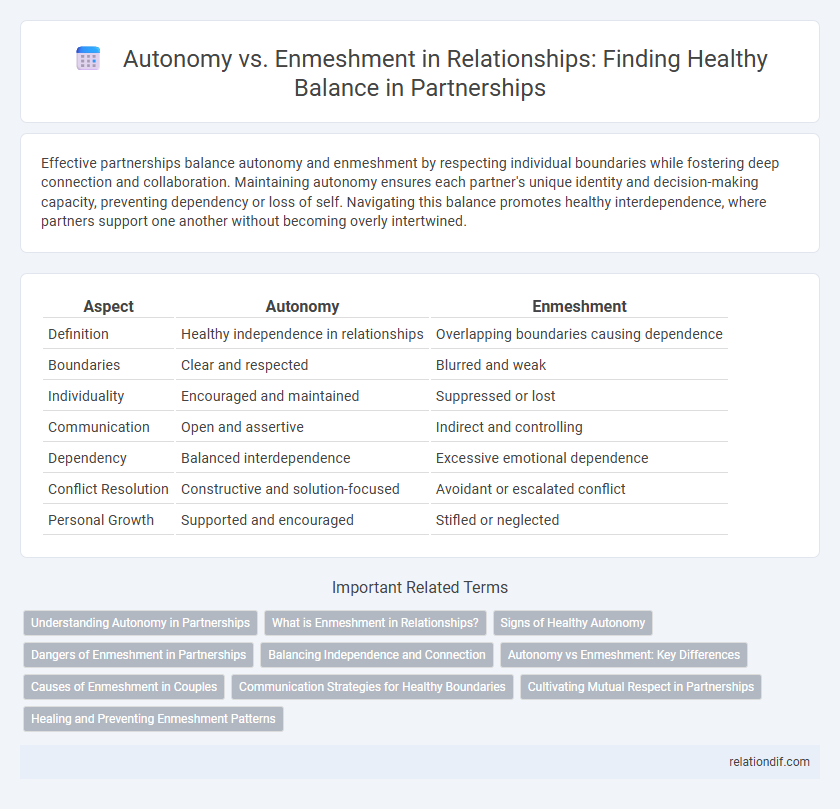Effective partnerships balance autonomy and enmeshment by respecting individual boundaries while fostering deep connection and collaboration. Maintaining autonomy ensures each partner's unique identity and decision-making capacity, preventing dependency or loss of self. Navigating this balance promotes healthy interdependence, where partners support one another without becoming overly intertwined.
Table of Comparison
| Aspect | Autonomy | Enmeshment |
|---|---|---|
| Definition | Healthy independence in relationships | Overlapping boundaries causing dependence |
| Boundaries | Clear and respected | Blurred and weak |
| Individuality | Encouraged and maintained | Suppressed or lost |
| Communication | Open and assertive | Indirect and controlling |
| Dependency | Balanced interdependence | Excessive emotional dependence |
| Conflict Resolution | Constructive and solution-focused | Avoidant or escalated conflict |
| Personal Growth | Supported and encouraged | Stifled or neglected |
Understanding Autonomy in Partnerships
Understanding autonomy in partnerships involves recognizing the importance of maintaining individual identity while fostering mutual support. Healthy partnerships balance personal boundaries with emotional connection, allowing partners to grow independently without losing a sense of togetherness. This equilibrium prevents enmeshment, where identities merge excessively, and encourages respect for each person's unique needs and aspirations.
What is Enmeshment in Relationships?
Enmeshment in relationships occurs when personal boundaries become blurred, leading to an excessive emotional dependence between partners. This lack of individuality often results in difficulty making decisions independently and a diminished sense of self. Understanding enmeshment is crucial for fostering autonomy and healthy interdependence within partnerships.
Signs of Healthy Autonomy
Signs of healthy autonomy in a partnership include clear personal boundaries, mutual respect for individual goals, and open communication that encourages independence without fear of judgment. Partners maintain their distinct identities while fostering emotional connection and support. This balance promotes growth and prevents enmeshment, leading to a more resilient and satisfying relationship.
Dangers of Enmeshment in Partnerships
Enmeshment in partnerships undermines individual autonomy, leading to blurred personal boundaries and increased codependency. This dynamic fosters emotional suffocation, diminishing personal growth and self-identity. Excessive enmeshment correlates with heightened conflict, reduced trust, and impaired decision-making within relationships.
Balancing Independence and Connection
Balancing autonomy and enmeshment in a partnership requires establishing clear personal boundaries while maintaining emotional connection. Partners foster independence by respecting individual goals and decisions, ensuring mutual trust and support. Achieving this balance enhances relationship resilience and personal growth within the couple dynamic.
Autonomy vs Enmeshment: Key Differences
Autonomy in a partnership emphasizes independent decision-making, personal growth, and clear boundaries, whereas enmeshment blurs these boundaries, leading to dependency and loss of individual identity. Key differences include emotional regulation, with autonomy fostering self-soothing abilities, while enmeshment results in heightened emotional reactivity due to over-reliance on the partner. Healthy partnerships balance autonomy and connection, promoting mutual respect and individual freedom without sacrificing intimacy.
Causes of Enmeshment in Couples
Enmeshment in couples often stems from blurred boundaries caused by excessive emotional dependency and lack of individual identity within the relationship. Causes include unresolved childhood trauma, codependency patterns, and fear of abandonment, which prevent healthy autonomy. Persistent enmeshment leads to restricted personal growth and stifled communication, undermining the partnership's balance.
Communication Strategies for Healthy Boundaries
Effective communication strategies for autonomy versus enmeshment emphasize clear, respectful expression of individual needs while honoring the partnership's shared goals. Setting healthy boundaries involves active listening, assertive dialogue, and mutual validation to prevent over-dependency or disengagement. Consistent use of "I" statements and scheduled check-ins supports balanced connection and personal independence within the relationship.
Cultivating Mutual Respect in Partnerships
Cultivating mutual respect in partnerships requires balancing autonomy and enmeshment by acknowledging each individual's boundaries while fostering open communication. Emphasizing personal growth alongside shared goals strengthens trust and prevents dependency or over-involvement. Establishing clear expectations promotes healthy interdependence, ensuring both partners feel valued and supported.
Healing and Preventing Enmeshment Patterns
Healing enmeshment patterns within partnerships requires setting clear emotional boundaries and fostering individual autonomy. Encouraging self-awareness and promoting open communication help partners maintain distinct identities while cultivating mutual support. Establishing these dynamics prevents codependency and nurtures a balanced, healthy relationship.
Autonomy vs Enmeshment Infographic

 relationdif.com
relationdif.com